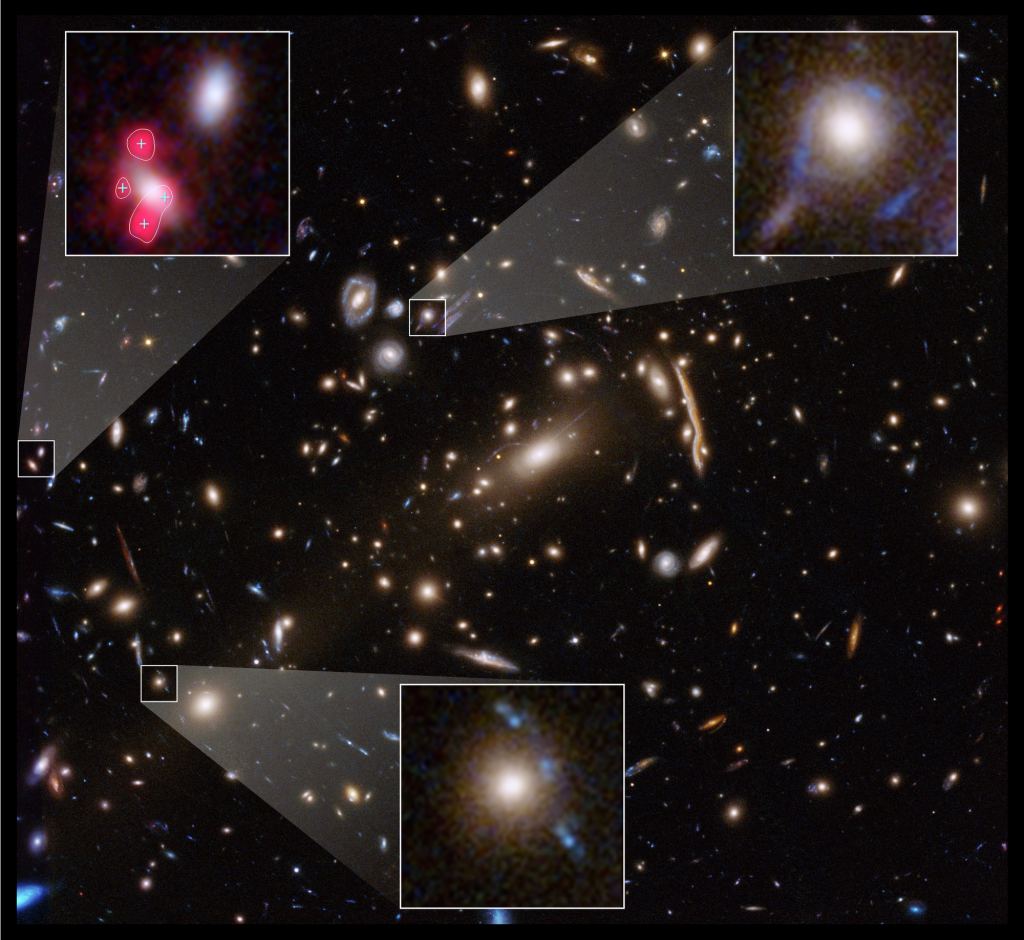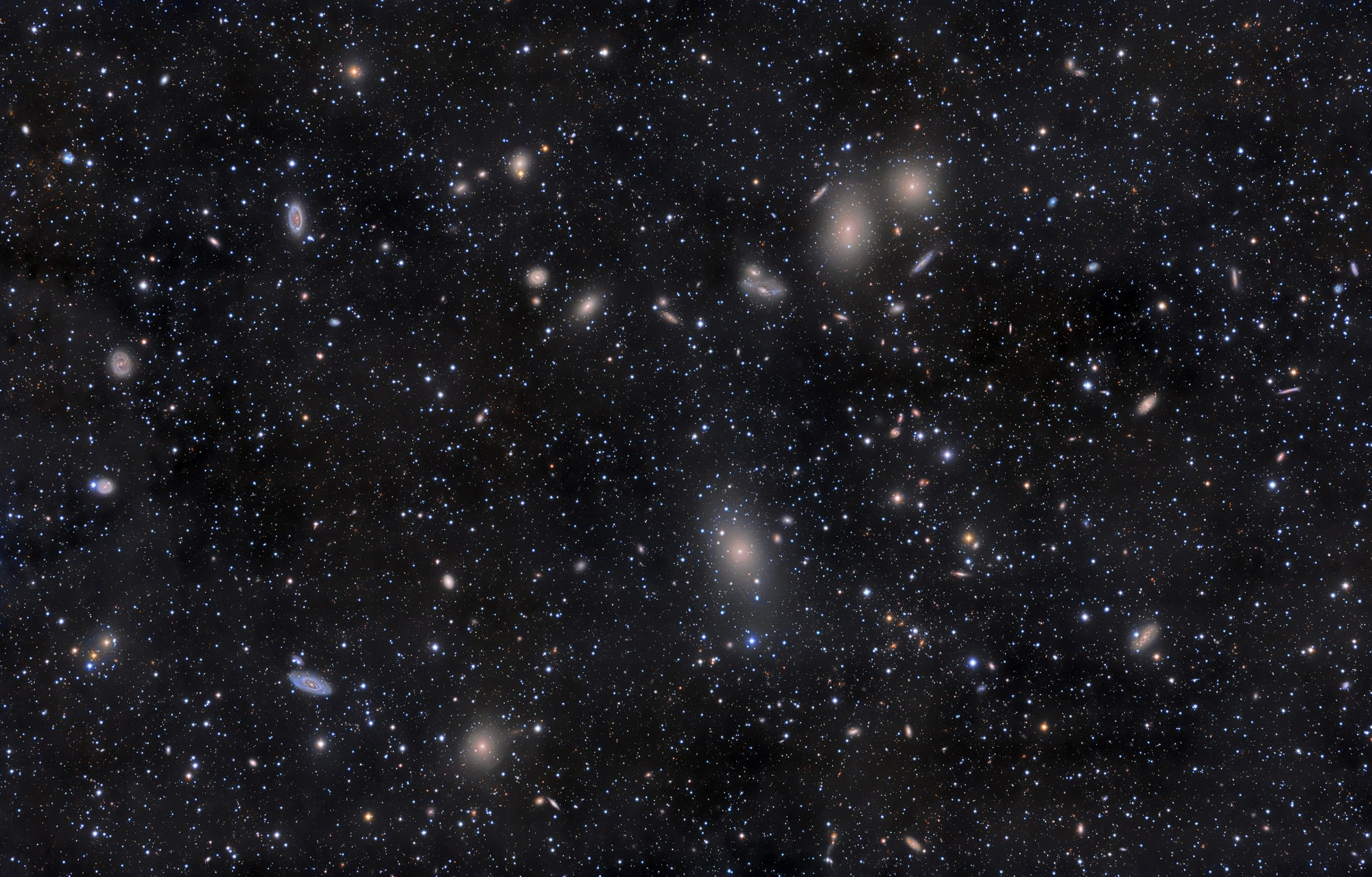Dark matter is difficult for astronomers to study, but that doesn’t keep them from trying. And with skill and determination, they continue to find exciting things about the invisible stuff.
Because dark matter doesn’t emit or absorb light, there are only a few ways to determine how dark matter is distributed throughout the cosmos. One way is to look at the grouping of galaxies into superclusters. The idea is that since dark matter exerts a gravitational pull on nearby matter, galaxies will tend to be where dark matter is most plentiful. The clustering we observe is in general agreement with dark matter models.
Another way to study dark matter is to see how it causes light to bend. Light is often seen to gravitationally lens around galaxies and galaxy clusters. By measuring where the lensing of light occurs, we can get a rough idea of how dark matter is clustered. From this, we think that dark matter tends to be broadly distributed within galaxy clusters. But a new study of gravitational lensing has given us a few surprises.

Recently a team used observations from the Hubble Space Telescope and the Very Large Telescope. By combining data, they were able to make high-resolution gravitational lensing maps of a few galaxy clusters. They found the overall lensing effects we’ve seen before, but they also found strong lensing effects around several individual galaxies within the clusters.
This means that dark matter must be densely clustered within individual galaxies since only dense dark matter can create a strong gravitational lens. In other words, dark matter seems to clump much more strongly than we’ve thought.
We aren’t entirely sure why this strong clustering of dark matter occurs, but it does rule out some dark matter theories. We’ve known, for example, that dark matter must be mostly “cold,” meaning that individual dark matter particles can’t be moving through space at high speeds. This is one of the reasons we know that neutrinos can’t make up dark matter. While neutrinos don’t interact strongly with light and are, therefore, a form of “dark” matter, neutrinos are “hot” because they move at a large fraction of light’s speed. Hot dark matter doesn’t form the type of clumps we see in dark matter.
To form the kind of dense clumps seen in this new result, at least some dark matter must be quite cold. The big question is how it could get so cold. One idea is that dark matter interacts with itself. When dark matter is clumped together by gravity, dark matter particles can collide in a way that releases energy, thus cooling dark matter. We see this kind of cooling in regular matter, but ordinary matter does this by releasing light energy.
Some dark matter theories propose a form of dark matter that can also release light when interacting. But so far, studies that have searched for such emitted light have come up empty.
Like many dark matter studies, this new work both answers and raises questions about dark matter. The team hopes that future studies will further narrow down the range of possible theories, but we remain a bit in the dark until then.
Reference: Massimo Meneghetti, et al. “An excess of small-scale gravitational lenses observed in galaxy clusters.” Science Vol. 369, no. 6509, (2020).


The descriptions of this result made me excited at first, despite the low number of objects, since the effect was so strong and it could mean something new. However it was soon obvious that they had picked a dark matter system subset consisting of large galaxy clusters with thousand of galaxies, where we also don’t know much about the infalling gas and its feedback effects. C.f. how knowing such feedback solved the “cusp-core” problem.
The paper itself lists four previous cases of such narrow discrepancies and note that they have all been solved – the “missing satellite”, “cusp-core”, “too-big-to-fail” discrepancies as well as discrepancies with planes of satellite galaxies. AFAIK all those discrepancies had resolutions in the baryonic matter sector.
And right after the release a set of two papers were published which each find correlations between such large galaxy clusters and two recently problematic sets of objects.
“Astronomers have found that the key to understanding galaxies with “extreme” sizes, either small or large, may lie in their surroundings. In two related studies, an international team found that galaxies that are either “ultra-compact” or “ultra-diffuse” relative to normal galaxies of comparable brightness appear to reside in dense environments, i.e., regions that contain large numbers of galaxies. This has led the team to speculate that these “extreme” objects could have started out resembling normal galaxies, but then evolved to have unusual sizes through interactions with other galaxies.”
[ https://disq.us/url?url=https%3A%2F%2Fphys.org%2Fnews%2F2020-09-galactic-census-reveals-extreme-galaxies.html%3AYG2H4YsTZzM4ide-krb7sOQghlM&cuid=653846 ]
Besides explaining more of ultra-diffuse galaxies, the ultra-compact halos distribution may be valuable in this context. Origin of ultracompact halos: “… a galaxy that has gradually been stripped away by gravitational tidal forces …”.